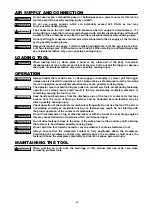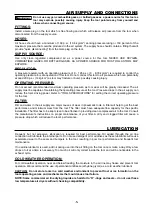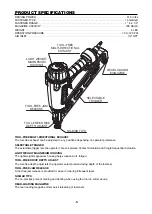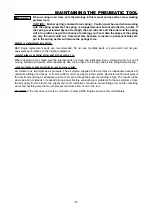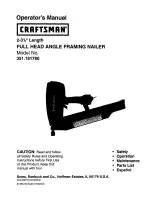
-4-
AIR SUPPLY AND CONNECTION
Do not use oxygen, combustible gases, or bottled gases as a power source for this tool as
tool may explode, possibly causing injury or death.
Do not use supply sources which can potentially exceed 200 P.S.I.G. as tool may
burst, possibly causing injury.
The connector on the tool must not hold pressure when air supply is disconnected.
If a
wrong fitting is used, the tool can remain charged with air after disconnecting and thus will
be able to drive a fastener even after the air line is disconnected possibly causing injury.
Do not pull trigger or depress contact arm while connected to the air supply as the tool may
cycle, possibly causing injury.
Always disconnect air supply: 1.) Before making adjustments; 2.) When servicing the tool;
3.) When clearing a jam; 4.) When tool is not in use; 5.) When moving to a different work area,
as accidental actuation may occur, possibly causing injury.
LOADING TOOL
When loading tool: 1.) Never place a hand or any other part of the body in fastener
discharge area of tool; 2.) Never point tool at anyone; 3.) Do not pull the trigger or depress
the trip as accidental actuation may occur, possibly causing injury.
OPERATION
Always handle the tool with care: 1.) Never engage in horseplay; 2.) Never pull the trigger
unless nose is directed toward the work; 3.) Keep others a safe distance from the tool while
tool is in operation as accidental actuation may occur, possibly causing injury.
The operator must not hold the trigger pulled on contact arm tools except during fastening
operation as serious injury could result if the trip accidentally contacted someone or
something, causing the tool to cycle.
Keep hands and body away from the discharge area of the tool. A contact arm tool may
bounce from the recoil of driving a fastener and an unwanted second fastener may be
driven possibly causing injury.
Check operation of the contact arm mechanism frequently. Do not use the tool if the arm is
not working correctly as accidental driving of a fastener may result. Do not interfere with
the proper operation of the contact arm mechanism.
Do not drive fasteners on top of other fasteners or with the tool at an overly steep angle as
this may cause deflection of fasteners which could cause injury.
Do not drive fasteners close to the edge of the work piece as the wood may split, allowing
the fastener to be deflected possibly causing injury.
Do not point the tool toward yourself or anyone whether it contains fasteners or not.
Always ensure that the workpiece contact is fully positioned above the workpiece.
Positioning the workpiece contact only partially above the workpiece could cause the
fastener to miss the workpiece completely and result in serious personal injury.
MAINTAINING THE TOOL
When working on tools note the warnings in this manual and use extra care when
evaluating problem tools.




